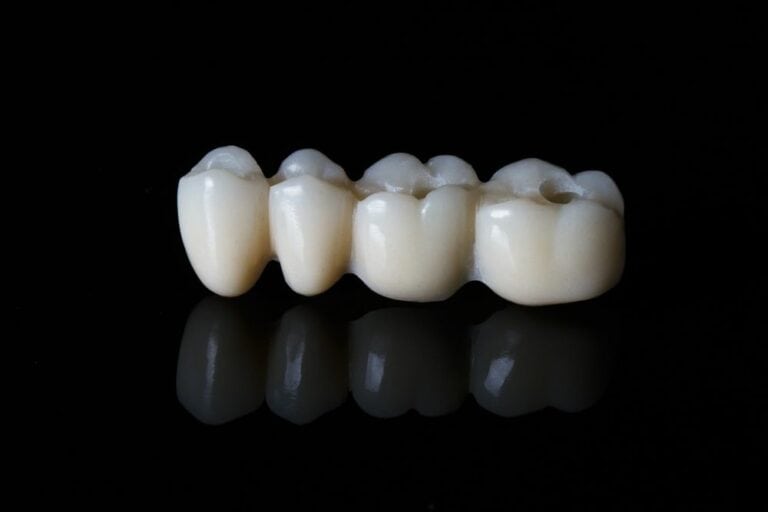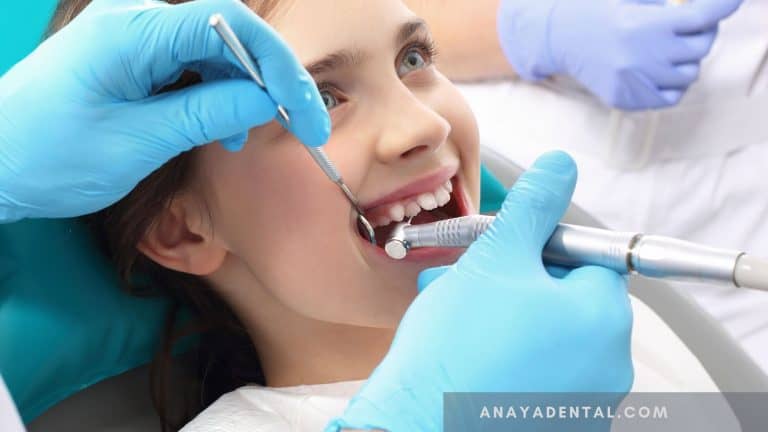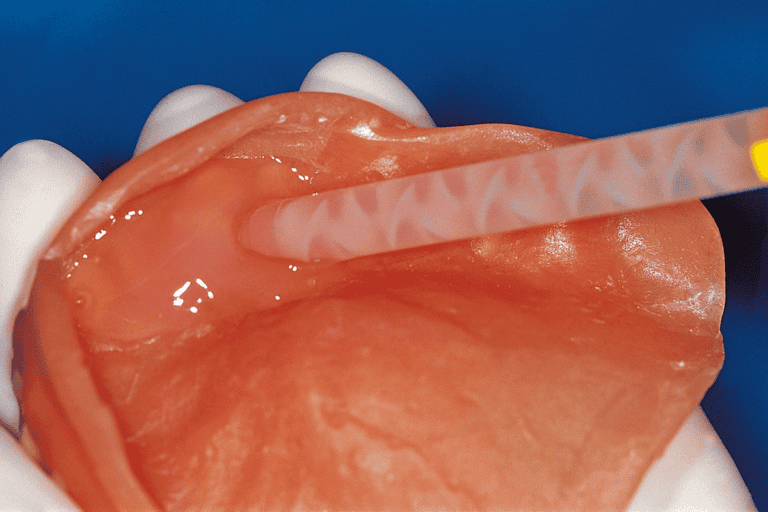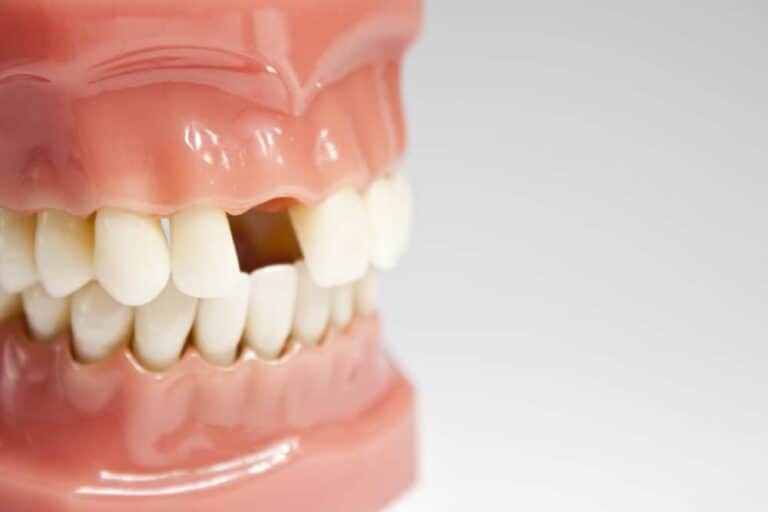Missing teeth can impact your smile, confidence, and even your ability to chew comfortably. Dental bridges offer a welcome solution, restoring a natural look and function. These bridges act like miniature suspension bridges, with crowns placed on healthy teeth on either side of the gap supporting artificial teeth in between.
While dental bridges are a valuable dental tool, they aren’t invincible. One potential downside is the increased risk of tooth decay developing under the bridge itself. This might seem counterintuitive, but the bridge structure can create hidden nooks and crannies that are difficult to clean with traditional brushing and flossing. This hidden environment can become a breeding ground for plaque and bacteria, leading to cavities in the teeth supporting the bridge.

In this article, we will discuss the symptoms of an ill-fitting dental bridge, its causes, treatment, and precautionary measures.
7 Main causes of tooth decay under a bridge
Dental bridges are fantastic restorations, but like anything else, they require proper care to function optimally and prevent complications. Let’s explore some key factors that can impact the health of your teeth and gums under a bridge:
Ill-fitting dental bridge
A loose dental bridge creates a hidden cavity where food particles can become trapped. Since regular brushing might not reach these areas effectively, food debris decomposes, leading to decay and potential infection in the supporting teeth.
Poor oral hygiene
For a long-lasting dental bridge, maintaining a thorough oral hygiene routine is crucial. Brushing twice a day and flossing once a day are essential practices. However, flossing under the bridge itself can be challenging. Here’s where interdental brushes or a waterpik come in handy.
Cleaning challenges
Dental bridges create a physical barrier, making it difficult to reach and remove plaque buildup under the pontic (artificial tooth). This plaque harbors bacteria that feast on food particles, releasing acids that erode tooth enamel, leading to decay.
Gum disease
Pre-existing gum disease, characterized by inflamed and infected gums, can pose a threat to your bridge. The infection can easily spread to the tissues surrounding the bridge, leading to further complications. For this reason, it’s vital to address any gum disease or periodontal issues before undergoing dental bridge placement.
Trauma
Any physical injury or trauma to the bridge or surrounding teeth can increase the risk of infection. Trauma can create small gaps where bacteria can enter and wreak havoc.
Bridge breakdown
Over time, the margins (edges) where the bridge meets the abutment teeth might develop small gaps due to wear and tear. These tiny leaks allow plaque and bacteria to infiltrate the vulnerable areas underneath, increasing the risk of decay.
Recurrent decay
If the abutment teeth already have existing cavities or weakened areas, they’re more susceptible to recurrent decay under the bridge. The bridge can trap bacteria and prevent proper treatment of these pre-existing issues, allowing decay to progress further.
Tooth decay under bridge symptoms or dental bridge infection symptoms
A dental bridge is an excellent solution to restore your smile, but it isn’t immune to decay. The bridge’s structure can make it challenging to clean underneath, where tooth decay may go unnoticed. Here’s how to recognize symptoms of tooth decay or infection under a dental bridge:
- Cleaning Challenges: Although brushing and flossing are vital for oral hygiene, it might be difficult to maneuver tools under the bridge. This can allow plaque buildup and potential decay to hide beneath.
- Persistent Bad Breath (Halitosis): Trapped food particles under the bridge can decompose, leading to continuous bad breath that regular brushing doesn’t resolve.
- Tooth Sensitivity: Experiencing sharp pain or discomfort in a tooth supporting the bridge when consuming hot or cold items might indicate exposed dentin due to decay beneath the bridge.
- Chewing Discomfort: If chewing causes pain or discomfort, it might suggest that decay has progressed in the supporting tooth, affecting its structure and functionality.
- Changes in Tooth Appearance: Look for signs like discoloration, darkening, or visible chips and cracks on the tooth under the bridge, which could indicate decay.
- Bridge Instability: A loose or shifting bridge might signal underlying decay in the supporting teeth, potentially weakening their structure.
It’s crucial to seek immediate dental care if you notice any of these symptoms to prevent further complications and maintain overall oral health.
Actions to be taken for tooth infection under a bridge
Early detection and timely treatment are crucial in preventing serious complications from tooth decay beneath a dental bridge. Here’s why taking prompt action is so important:
The Importance of Early Action: Addressing decay early helps minimize damage to the tooth structure and surrounding bone. Catching it early means treatments can be simpler and more cost-effective.
X-Ray Diagnosis for Accurate Assessment: To accurately assess the extent of decay, your dentist will likely use X-ray technology. This provides a detailed view beneath the bridge, enabling a precise evaluation and the formulation of an effective treatment plan.

Treatment options for tooth decay under bridge
The treatment approach will vary based on how severe the decay is:
Filling the Gap: For minor decay, the dentist might temporarily remove the bridge to gain access to the affected area and place a filling. Afterward, the bridge is securely recemented, restoring the integrity of your dental work.
Root Canal Therapy: If the decay has penetrated the tooth’s inner chamber, root canal therapy may be necessary. This involves removing the infected pulp, cleaning the root canals, and sealing the tooth. A crown is then placed to reinforce the tooth and support the bridge.
Bridge Replacement: In cases where decay is extensive or the bridge itself is compromised, a complete replacement of the bridge may be necessary to ensure both functionality and aesthetics.
Dental Extraction: If the decay is too severe to manage with a root canal, extracting the tooth under the bridge may be the last resort. Subsequent options, such as dental implants, can be considered to restore functionality and appearance.
How to Prevent Tooth Decay Under a Bridge?
Proper oral hygiene under a bridge is crucial due to the difficulty of cleaning hidden areas. Here’s how to prevent decay and ensure the longevity of your bridge:
- Master the Art of Bridge Flossing: Use floss threaders, which resemble a needle with a short piece of floss attached, to thread the floss under the bridge and slide it back and forth to remove plaque and food particles.
- Regular Dental Checkups and Cleanings: Maintain biannual dental visits for professional cleaning under the bridge. Early detection of decay is crucial, and your dentist is skilled at identifying potential issues early.
- Waterpik to the Rescue: A Waterpik, or oral irrigator, uses a pressurized water stream to effectively remove plaque and debris from under the bridge and along the gum line.
- Interdental Brushes: These small brushes are designed to fit between teeth and under bridges, excellent for removing plaque and food particles.
- Replacing Worn Bridges: Over time, bridges may wear down or develop small gaps that harbor bacteria and food particles, increasing decay risk. Replacing worn bridges is necessary to prevent future decay and maintain oral health.
By following these preventive measures, you can significantly reduce the risk of tooth decay under your bridge, ensuring its effectiveness and keeping your smile beautiful and healthy.
Conclusion
Dental bridges are an excellent restoration option, but like any investment, they require proactive maintenance to retain their functionality and prevent hidden threats such as tooth decay. This guide equips you with the knowledge to champion the health of your bridge.
Early detection is your ultimate defense against decay beneath your bridge. By addressing issues promptly, you can minimize damage and potentially avoid costly procedures down the line. Consider it preventative maintenance for your smile!
Regular dental checkups are crucial for the care of your bridge. These visits allow for professional deep cleaning and the early detection of any potential problems. Think of your dentist as a dental detective, identifying and addressing issues before they become serious.
With consistent care and the insights from this guide, you can ensure your dental bridge thrives for years to come. A healthy bridge leads to a beautiful smile, boosting your confidence and bridging the gap to a lifetime of oral health success!
FAQs
What happens if there is decay under a bridge?
Tooth decay under a bridge can go unnoticed, silently causing damage. This hidden enemy weakens teeth, fuels infection, and might loosen the bridge itself. Early detection through regular dental visits and meticulous cleaning with floss threaders or waterpiks is crucial to save your smile and bridge.
Can you fix a tooth under a bridge?
Yes, if the decay is minor to moderate. The plan of treatment is:
- Minor Decay: Your dentist might remove the bridge for easier access, then place a filling to restore the damaged tooth. Once the filling is complete, the bridge will be securely recemented.
- Extensive Decay: If the decay is deep or reaches the tooth’s nerve, a root canal might be necessary. After a successful root canal, your dentist can place a crown on the tooth to restore its strength and support the bridge. In some cases, the bridge itself might need replacing.
How do I know if my tooth is infected under my bridge?
A throbbing toothache, persistent bad breath, or a loose bridge could signal an infection under your bridge. Also, refer to the symptoms of infection under a bridge explained earlier in the article.
Is it painful to have a dental bridge removed?
Removing a dental bridge typically isn’t painful. Dentists use anesthesia to numb the area, so you might feel pressure but minimal discomfort. However, some anxiety is normal.
Nerve pain under dental bridge
Experiencing sharp pains, tingling, or unusual sensitivity in a tooth under your bridge could indicate nerve damage. This can occur for two reasons:
- Bridge Placement: Sometimes, the process of placing the bridge might irritate the nerve in the supporting tooth, causing temporary discomfort.
- Untreated Decay: More concerning is the possibility of nerve damage due to untreated decay under the bridge. As decay progresses, it can reach the tooth’s inner chamber (pulp) containing the nerve, leading to significant pain and sensitivity.
Early diagnosis is crucial. Schedule a dental visit to determine the cause and receive appropriate treatment. Addressing the issue promptly can prevent further nerve damage and potentially save your tooth.
Tooth under bridge broke
A broken tooth under your bridge can be a dental emergency! The bridge itself might become loose or damaged. Pain and sensitivity are likely. Contact your dentist immediately to assess the damage. Depending on the break’s severity, they might repair the tooth, replace the bridge, or recommend alternative solutions.
Cracked tooth under bridge symptoms
A cracked tooth under your bridge can be tricky to detect, but some signs might raise a red flag:
- Sharp Pain: Chewing or biting down might cause sudden, sharp pains in the tooth under the bridge.
- Sensitivity: Increased sensitivity to hot, cold, or sweet foods and beverages could indicate a crack exposing the inner tooth.
- Discomfort: A general feeling of discomfort or achiness in the tooth might linger.





